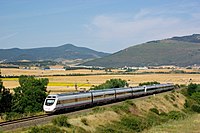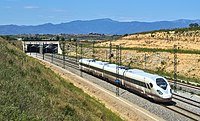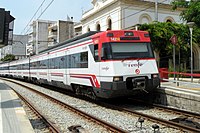Renfe (Spanish pronunciation: [ˈreɱfe], Eastern Catalan: [ˈreɱfə]), officially Renfe-Operadora, is Spain's national state-owned railway company.[3]
 | |
| Company type | Statutory corporation |
|---|---|
| Industry | Rail transport |
| Founded | 1 January 2005 |
| Headquarters | , Spain |
Key people | Isaías Táboas (CEO), Enrique Peña Pérez, Manuel Fresno Castro, José Luis Marroquín |
| Products | Rail passenger and freight transport |
| Revenue | |
| Owner | Spanish government (100%) |
Number of employees | |
| Subsidiaries |
|
| Website | renfe.com |


It was created in 2005 upon the split of the former Spanish National Railway Network (Renfe) into the Administrador de Infraestructuras Ferroviarias (ADIF), which inherited the infrastructure, and Renfe-Operadora, which inherited the railway service.
History
The name "Renfe" (acronym of Red Nacional de los Ferrocarriles Españoles) is derived from that of the former Spanish National Railway Network created on 24 January 1941 with the nationalisation of Spain's railways. As per EU Directive 91/440, Renfe was divided into Renfe Operadora (operations) and ADIF (infrastructure) on 1 January 2005. At the same time, the existing Renfe logo (nicknamed the "galleta", Spanish for biscuit), first introduced in 1971, was replaced by a dark purple lower-case wordmark designed by Interbrand. Separate logos used by the other sectors were also replaced, but the old Renfe logo remains in use in some stations in Spain and on maps to indicate an ADIF station.
The Railway Sector Act, 2003 separated the management, maintenance and construction of rail infrastructure from train operation. The first activity is now the responsibility of Administrador de Infraestructuras Ferroviarias (ADIF), while the newly created Renfe-Operadora (also known as Grupo Renfe or simply Renfe) owns the rolling stock and remains responsible for the planning, marketing and operation of the passenger and freight services.[4]
Renfe no longer has a monopoly on domestic passenger services due to Ouigo España launching in 2021, followed by Iryo in 2022.[citation needed]
Structure
Renfe-Operadora inherited the management model of the old Renfe, which made Renfe-Operadora responsible for the operation of the passenger and freight services. In January 2006, Renfe-Operadora restructured the main business units into four general directorates:
- Dirección General de Servicios Públicos de Cercanías y Media Distancia (General Public Utilities Directorate for Suburban and Medium Distance): responsible for commuter services (Cercanías), medium-distance high-speed rail AVE services and medium-range regional services (es:Regionales and es:Media Distancia). However, control of some Cercanías services were transferred to Spain's Autonomous communities.
- Dirección General de Servicios de Larga Distancia (General Directorate of Long Distance Services): responsible for long-distance intercity and high-speed rail services (except medium-distance AVE services and Media Distancia, which is managed by the above business unit).
- Dirección General de Servicios de Mercancías y Logística (General Directorate for Freight and Logistics Services): responsible for freight services.
- Dirección General de Fabricación y Mantenimiento (General Directorate of Manufacturing and Maintenance): responsible for rolling stock maintenance and manufacture (also known as Integria)
In June 2013, Renfe's board agreed to restructure the group into four separate companies under the holding company:[5][6]
- Renfe Viajeros, operating passenger trains;
- Renfe Mercancías, freight;
- Renfe Fabricación y Mantenimiento, rolling stock maintenance;
- Renfe Alquiler de Material Ferroviario, train leasing.
Figures
| Figures[7] | 2006 | 2007 | 2008 | 2009 | 2010 | 2011 | 2012 | 2013 | 2014 | 2015 | 2016 | 2017 | 2018 | 2019 |
|---|---|---|---|---|---|---|---|---|---|---|---|---|---|---|
| Passengers (Mio.)[8] | 527,975 | 517,583 | 510,176 | 476,334 | 463,012 | 476,917 | 472,145 | 466,057 | 464,961 | 465,201 | 471,359 | 487,881 | 507,088 | 510,453 |
| Passenger-kilometer (Mio.) | 20,480 | 20,167 | 22,281 | 21,895 | 21,166 | 21,585 | 21,319 | 22,563 | 23,754 | 24,825 | 25,291 | 26,060 | 26,931 | 27,263 |
| AVE Passengers (Tsd.) | 4.878 | 5.559 | 11.461 | 11.250 | 10.851 | 12.563 | 12.101 | 14.697 | 17.967 | 19.428 | 20.352 | 21.108 | 21.332 | 22.370 |
| AVE Passenger-kilometer (Tsd.) | 1.884 | 2.161 | 4.888 | 5.260 | 5.171 | 5.846 | 5.793 | 7.095 | 8.038 | 9.230 | 9.632 | 10.267 | 10.289 | 10.760 |
Operations
The company operates some 12,000 km (7,500 mi) of railways, 7,000 km (4,300 mi) of them electrified. Most of the tracks are constructed to the broadIberian gauge of 1,668 mm (5 ft 5+21⁄32 in), the same as that used in Portugal but wider than the international gauge of 1,435 mm (4 ft 8+1⁄2 in) which is standard in most of the rest of the world. The newer high-speed (AVE) network has been built to the international standard gauge of 1,435 mm for the connection to the rest of the European railway system. For this reason, the 1,435 mm gauge is generally termed "European gauge" in Spain.[citation needed]
Construction of a high-speed rail line between Madrid and Seville began in 1988 and began operations in 1991, going 300 km/h (190 mph). The second high-speed rail line (Madrid to Barcelona) was completed in 2007 with the inaugural service commencing on 20 February 2008. The operational speed on this route is 350 km/h (220 mph). The greater part of the line (Madrid to Lleida) was entered service on 11 October 2003, with a connection to Huesca from Zaragoza. The third high-speed line (Madrid to Toledo) was opened in November 2005, followed by a spur from Córdoba to Málaga as far as Antequera in 2007. Another high-speed route from Madrid to Valladolid was opened in 2007. A line from Madrid to Valencia was opened in 2010, and the first stage of a high-speed line in Galicia opened in 2011. A line to Lisbon is being designed.[citation needed]
Other lines operated by Renfe include Euromed, a moderate-speed line between Barcelona and Alicante.
In addition to intercity transport, Renfe operates commuter train systems, known as Cercanías (or Rodalies in Catalonia and Cercanías-Aldirikoak in the Basque Country), in eleven metropolitan areas, including Madrid and Barcelona. In some cities, Renfe shares the market with other commuter railway operators, such as FGC.
In 2019, Renfe solicited bids for 31 new trains for the Asturias and Cantabria regions and the €258m contract was awarded to the CAF (Construcciones y Auxiliar de Ferrocarriles) in June 2020. Around February 2023, authorities discovered the designs were for the wrong loading gauge and would be too wide for the tunnels.[9] Amidst international embarrassment, Renfe and ADIF each tried to deflect responsibility, and some called for the firing of the executives deemed responsible. Fortunately, the trains were still being designed, however the Cercanía commuter trains will be delayed until 2026.[10][11][9] Subsequently, transport officials including the president of Renfe and the Secretary of State for Transport resigned.[12]
Passenger rolling stock
Renfe-Operadora utilises the following rolling stock and commercial products inside of its two divisions:
Suburban and Medium Distance (DGSPCMD)
Cercanías AM (Meter Gauge Commuter Services)
| Rolling stock | Region(s) | Image |
|---|---|---|
| Feve Class 2400 DMU | Asturias Cantabria Galicia |  |
| Feve Class 2600 DMU | Asturias Castile and León |  |
| Feve Class 2700 DMU | Asturias Basque Country Cantabria Castile and León Galicia |  |
| Feve Class 2900 DMU | Castile and León Galicia Murcia |  |
| Feve Class 3300 EMU | Asturias |  |
| Feve Class 3500 EMU | Asturias |  |
| Feve Class 3600 EMU | Asturias Basque Country Cantabria |  |
| Feve Class 3800 EMU | Cantabria |  |
Cercanías (Commuter Services)
Mainline Medium Distance Services
| Rolling stock | Route(s) | Image |
|---|---|---|
| Renfe Class 440/470 EMU (to be phased out) | Córdoba – Rabanales León – Ponferrada – Vigo León – Gijón Valladolid – Santander Valladolid – Ávila Valladolid – León Valencia − Barcelona Valencia − Alicante |  |
| Renfe Class 448 EMU | Catalunya Aragón |  |
| Renfe Class 449 EMU | Madrid – Jaén León – Ponferrada – Orense – Vigo Sevilla – Cádiz Barcelona – Girona – Figueres – Portbou Huelva – Sevilla Jaén – Córdoba – Sevilla – Cadiz Madrid − Alcázar de San Juan − Albacete Madrid − Alcázar de San Juan − Ciudad Real Alicante – Albacete – Ciudad Real Madrid − León Madrid – Vitoria Irun - Vitoria - Miranda de Ebro Córdoba – Bobadilla Barcelona – Reus Barcelona – Tortosa |  |
| Renfe Class 592 DMU (to be phased out) | Madrid – Talavera Murcia – Cartagena Valencia − Alcoi CELTA: Oporto - Vigo (Service CP) |  |
| Renfe Class 594 DMU | Valladolid – Zamora – Puebla de Sanabria A Coruña – Ferrol A Coruña – Lugo – Monforte de Lemos - Ourense Madrid – Soria Murcia – Cartagena |  |
| Renfe Class 598 DMU | Cáceres – Valencia de Alcántara Sevilla – Cáceres - Madrid |  |
| Renfe Class 599 DMU | Madrid – Badajoz Huelva – Zafra A Coruña – Vigo Guixar Salamanca – Ávila – Madrid Salamanca – Palencia Valencia – Cartagena Zaragoza – Valencia Zaragoza – Cartagena Sevilla – Málaga Sevilla – Almería Granada – Algeciras Málaga – Ronda Granada – Linares Madrid − Águilas |  |
High-Speed Medium Distance Services
| Service | Rolling stock | Route(s) | Image |
|---|---|---|---|
| Avant | Renfe Class 104 EMU | Madrid – Toledo Madrid – Ciudad Real Málaga – Granada Sevilla – Córdoba Barcelona – Camp De Tarragona Sevilla - Málaga |  |
| Renfe Class 114 EMU | Madrid – Puertollano Madrid – Valladolid Barcelona – Figueres Barcelona – Lleida Sevilla – Granada |  | |
| Renfe Class 121 EMU | Cádiz – Jaén A Coruña – Ourense A Coruña – Vigo Urzaiz Madrid – Ponferrada Ponferrada-Vigo Madrid – Gandia Madrid-Salamanca |  |
Long Distance (DGSLD)
Luxury Tourist Train Services
Mainline Long Distance Services
| Service(s) | Route(s) | Locomotive | Passenger Car | Image |
|---|---|---|---|---|
| Intercity | Madrid – Algeciras Madrid – Granada Madrid – Murcia – Cartagena Madrid – Almería Barcelona – Murcia – Cartagena/Lorca Madrid – Cáceres – Badajoz | Renfe Class 334 Locomotive | Talgo Pendular |  |
| Madrid – Almería Barcelona – Murcia – Cartagena/Lorca Madrid – Valencia | Renfe Class 252 Locomotive | Talgo Pendular |  |
High-Speed Long Distance Services
| Service | Rolling stock | Route(s) | Image |
|---|---|---|---|
| AVE | Renfe Class 100 EMU | Madrid – Sevilla Madrid – Alicante Madrid – Marseille[1] Barcelona – Toulouse[2] Barcelona – Lyon[3] |  |
| Renfe Class 102 EMU | Madrid – Huesca Madrid – Zaragoza Madrid – Valladolid Madrid – Málaga Valencia – Sevilla |  | |
| Renfe Class 103 EMU | Madrid – Barcelona Madrid – Málaga |  | |
| Renfe Class 112 EMU | Madrid – Cuenca – Valencia Madrid – Cuenca – Albacete Madrid – León Barcelona – Málaga Barcelona – Zaragoza Barcelona – Sevilla |  | |
| Alvia (mixed high-speed & conventional service) | Renfe Class 120 EMU | Madrid – Pamplona Madrid – Logroño Madrid – Irún/Hendaya Madrid – Bilbao Madrid – Salamanca Barcelona – Irún Barcelona – Bilbao Barcelona – Pamplona Barcelona – Valladolid Torre del Oro: Barcelona – Valencia – Sevilla – Cádiz |  |
| Renfe Class 130 EMU | Madrid – Gijón Madrid – Santander Alicante – Gijón Alicante – Santander Madrid – Cádiz Madrid – Huelva Madrid – Valencia – Castellón Madrid – Valencia – Gandía Barcelona – A Coruña Barcelona – Vigo Barcelona – Gijón Euromed: Barcelona – Valencia – Alicante |  | |
| Renfe Class 730 HMU | Alicante – Madrid – Pontevedra Alicante – Madrid – A Coruña Madrid – Ferrol Madrid – Pontevedra Madrid – Ponferrada Madrid – Murcia Madrid – Badajoz |  |
Prototype rolling stock
| Service | Rolling stock | Image |
|---|---|---|
| AVE | Renfe Class 105 EMU |  |
| AVE | Talgo AVRIL EMU |  |
Future rolling stock
| Service | Rolling stock | Quantity |
|---|---|---|
| Ancho Metrico | Unknown Meter Gauge CAF EMU | 26 |
| Unknown Meter Gauge CAF BMU | 5 | |
| Cercanías | X'trapolis Coradia EMU | 152 |
| FLIRT/KISS EMU | 59 | |
| Unknown Meter Gauge CAF EMU | 6 | |
| Media Distancia | Unknown Iberian Gauge CAF EMU | 28 |
| AVE | Renfe Class 106 EMU | 30 |
| Renfe Class 107 EMU | 13 |
Vehicles register numbers
All classes are designated by three numbers. The first digit has a special meaning:
- 1xx: High speed multiple unit
- 2xx: Electric locomotive
- 3xx: Diesel locomotive
- 4xx: Electric multiple unit (EMU)
- 5xx: Diesel multiple unit (DMU)
- 6xx: Hybrid locomotive
- 7xx: Hybrid multiple unit (HMU)
- 8xx: Trams which can run on railways
Tickets
Travel tickets are available from rail stations and online. In 2023 the European Commission initiated an investigation into concerns that Renfe might have been abusing its dominant position in the online ticketing market by refusing to share journey time information with competing ticketing websites. Renfe offered a number of commitments intended to address these concerns, which the European Commission made legally binding in January 2024 under the EU's competition rules.[13]
See also
Notes
References
External links










